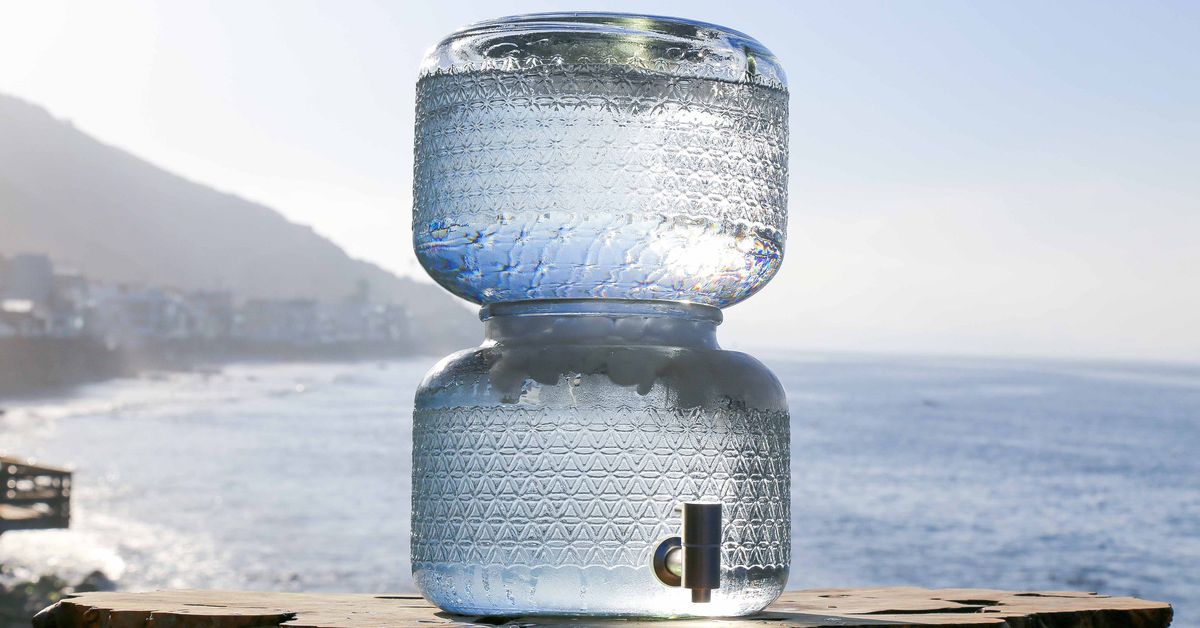What to know about the “raw water” trend

Untreated, unfiltered “raw water” is apparently the hot new fad around Silicon Valley, or so says a recent New York Times trend piece.
People are eschewing tap and bottled water in favor of an icy cold glass of untreated spring water — so-called “raw” or “unprocessed” water — which proponents say has beneficial minerals that are removed from treated or filtered water, and doesn’t include chemicals in tap water, such as fluoride, or move through infrastructure such as lead pipes.
Some are paying a lot more for the luxury of drinking water that might not have fluoride but could still have chemicals from pesticides and dangerous bacteria. Also animal poop.
The “raw water” trend — such as it is — fits into a larger movement that, first, embraces everything “natural” as healthy, and second, creates savvy entrepreneurs who find ways to make a lot of money from it. The Times article doesn’t offer much detail on how many people are embracing this fad and actually buying and drinking overpriced, untreated spring water. But unproven, unscientific “cures” are a growth market — and debunkings often have little effect.
True believers in “raw water” probably won’t be convinced. One of the companies mentioned in the Times piece said there’s already been a surge of demand. But at the risk of shouting into the void, we’ll say it again: Drinking untreated spring water is a very, very bad idea.
What is “raw water”?
The “raw water” movement has been around for several years — it had its roots in the raw food movement — but it’s been getting attention lately after companies started bottling and selling untreated spring water. In September, Doug Evans, the founder of Juicero, the startup that made that “smart juicer” the internet loved to mock, announced a five-day “water fast” in which he would only drink raw water.
“Raw” water proponents say it contains healthy and natural minerals that get stripped out when tap water or bottled water is filtered and treated. One “raw water” adherent told the Times that after making the switch, she noticed her “skin’s plumper” and she feels as if she’s “getting better nutrition from the food I eat.”
Now startups are capitalizing on the trend and selling “raw water.” Live Water bottles its water from a spring in Oregon, and the Times notes a few other startups — including Tourmaline Spring, based in Maine. Another, Zero Mass Water, caters to people who want to collect mineral-rich water from the “atmosphere around their homes,” which a company spokesperson says isn’t “raw water” but an “off-the grid alternative to tap water.”
“It has a vaguely mild sweetness, a nice smooth mouth feel, nothing that overwhelms the flavor profile,” Kevin Freeman, a shift manager at the store that sells a 2.5-gallon bottle of “raw water” bottled by Live Water for $36.99, told the New York Times. “Bottled water’s controversial. We’ve curtailed our water selection. But this is totally outside that whole realm.”
I need you to understand that in this article the Raw Water people are talking about the flavor profile & “mouth feel” of untreated, unfiltered water they found somewhere, for which they charge $36.99 per 2.5 gallons.
Spoiler: the mouth feel is giardia, the flavor is dysentery.
— Catherynne Valente (@catvalente) December 31, 2017
So for “raw water” fans, the idea is that tap or bottled water is kind of the processed food — the Twinkies — of water, whereas “raw water” is all natural, if imperfect, and offers a unique taste and benefits. (It’s also not exactly true that “raw water” is some coveted natural cure-all that modernity destroyed. As The Verge’s Rachel Becker points out, societies have been attempting water treatment for centuries.)
“Tap water? You’re drinking toilet water with birth control drugs in them,” Mukhande Singh, the founder of the Live Water startup, told the Times. “Chloramine, and on top of that they’re putting in fluoride. Call me a conspiracy theorist, but it’s a mind-control drug that has no benefit to our dental health.”
It’s true that trace amounts of prescription and over-the-counter medicines, and additives from shampoo and soap, can end up in water in low concentrations, but studies have shown that they aren’t harmful to people in such small amounts.
And the idea that fluoride is a mind control drug is a conspiracy theory with a long history. Before it was a “mind-control drug,” fluoride was suspected of being a communist plot. (It’s neither. The Centers for Disease Control and Prevention considers fluoridation to be one of its top 10 public health achievements of the past century because of its ability to help prevent tooth decay, particularly in kids and low-income Americans who might not have ready access to dental care.)
Drinking untreated water is a very bad idea
Let’s state the obvious here: Water treatment removes bacteria, parasites, pesticides, and other contaminants, and drinking untreated water come with serious risks.
In the United States, the Environmental Protection Agency, via the Safe Drinking Water Act, originally passed in 1974 (and updated since), sets health guidelines for the public wells, reservoirs, and springs many Americans rely on. Overall in the US, outbreaks from water-associated diseases are low. A CDC report released this year calculated 42 drinking water–associated outbreaks in 2013-’14, which caused 1,006 cases of illness, 124 hospitalizations, and 13 deaths. (The majority of the cases, and all of the deaths, were linked to Legionella, which causes Legionnaire’s disease — spread through inhaling the bacteria.)
Meanwhile, in the developing world, access to clean and sanitary water is a huge public health and human rights issue. Water-associated diseases such as cholera are still global threats. In 2017, an outbreak of cholera — which is spread by drinking water or eating food contaminated with a certain bacteria — reached 1 million suspected cases in Yemen, where a devastating famine has prevented access to clean water.
It is true that the United States has issues with its public water systems because of its aging infrastructure. The EPA has estimated the country will require a $384 billion investment in local water systems in the coming years to maintain clean water standards. And as many as 10 million lead pipes could still be in use, though Congress banned them three decades ago, according to the New York Times. The risks of lead leaching into water are legitimate — as the crisis in Flint, Michigan, proved in heartbreaking detail. Experts point to crumbling infrastructure, and the lack of resources to fix it, as contributing to the water-associated disease outbreaks that the US does experience.
But that doesn’t make the case for “raw water.” It’s an argument to reinvest in and improve the water infrastructure that already exists in the United States, particularly in rural and low-income areas that don’t always have the resources to replace aging pipes or treat water as robustly as it needs to be.
The “raw water” trend might be short-lived — but it has something in common with other pseudoscientific beliefs
The “raw water” trend might be fleeting — the appeal of potentially drinking animal pee could wear off — but it has something in common with other pseudoscientific theories that see “natural” as good and “chemical” as bad.
The motive that drives people to seek out possibly polluted spring water is a more extreme version of the same beliefs that drive everything from fears over GMO foods to more dangerous practices such as the anti-vaccination movement. Engaging in these bogus practices sometimes does nothing more than needlessly drain your wallet, but others could pose health consequences. Those who choose not to vaccinate, for example, despite the ample science that backs up vaccines’ value, put the most vulnerable at risk by sacrificing herd immunity.
As James Hamblin writes at the Atlantic about the “sanctimony” of the natural, “people use biological arguments to justify the same belief that has been around since the beginning of time: New things are unnatural and dangerous. Stuff was better before.”
There is also the reality that modern medicine hasn’t always fulfilled its promises. As Vox’s Julia Belluz wrote about Goop’s ability to galvanize its fans despite critical and scientific debunking, the appeal of a natural cure-all deeply appeals to people:
Traditional medicine has failed people in many cases, and often lacks solutions for the most common health woes — chronic pain, obesity, Alzheimer’s. You need not look any further than the raging opioid epidemic to find cases where medicine has also done more harm than good.
And it is hard to persuade people that they’re wrong once they’re sure fluoride is a government attempt at mind control. People tend to rally around their beliefs once they’re convinced of their authenticity, regardless of facts. Sometimes those false beliefs become deeply held because they offer a satisfying explanation that otherwise wouldn’t exist — vaccines cause autism, for example — and other times it’s because they match up with values, such as personal liberty.
The bigger problem isn’t in convincing the raw water enthusiasts, or those who worry about GMOs, that they’re wrong. It’s that these ideas tend to migrate from the margins and cast doubt among the general public. The anti-vaccine movement offers an example of this: Vocal anti-vaxxers are likely a smaller group compared to people who are influenced by those views. They still generally believe in the benefits of vaccines, but they may delay or skip certain immunizations because of concerns that they’re too much or unnecessary.
The “raw water” movement might be a passing fad. But sowing skepticism about water infrastructure or the importance of treated water is worrisome — and could have real consequences. According to Business Insider, the price of one brand of raw water has already doubled. It’s now going for $60.
Update: This post has been updated with a statement from Zero Mass Water.
*** This article has been archived for your research. The original version from Vox.com can be found here ***


